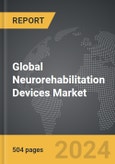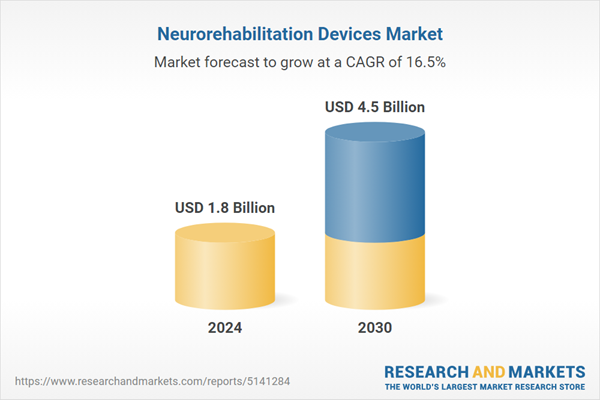The global market for Neurorehabilitation Devices was valued at US$1.8 Billion in 2024 and is projected to reach US$4.5 Billion by 2030, growing at a CAGR of 16.5% from 2024 to 2030. This comprehensive report provides an in-depth analysis of market trends, drivers, and forecasts, helping you make informed business decisions. The report includes the most recent global tariff developments and how they impact the Neurorehabilitation Devices market.
The development and implementation of neurorehabilitation devices are driven by advancements in neuroscience, robotics, and digital health technologies. Robotic exoskeletons and assistive devices enable patients to perform repetitive movements, promoting neuroplasticity and motor recovery. BCIs facilitate communication between the brain and external devices, helping patients regain control over their movements. Neurostimulation devices, such as transcranial magnetic stimulation (TMS) and transcranial direct current stimulation (tDCS), modulate neural activity to improve cognitive and motor functions. VR-based systems create immersive environments for cognitive and physical exercises, making rehabilitation engaging and effective.
The growth in the neurorehabilitation devices market is driven by several factors. Firstly, the increasing prevalence of neurological disorders and the rising number of stroke and injury cases are significant drivers. Secondly, advancements in neuroscience and rehabilitation technologies are enhancing the effectiveness and adoption of these devices. Thirdly, the growing awareness of the benefits of early and intensive rehabilitation is boosting demand for neurorehabilitation devices. Additionally, the integration of digital health technologies and remote monitoring is making rehabilitation more accessible and personalized. Furthermore, supportive government policies and funding for research and development in neurorehabilitation are encouraging innovation. Lastly, the expansion of healthcare infrastructure and the increasing availability of specialized rehabilitation centers are further driving market growth.
Segments: Product (Neurorobotic Systems, Brain Computer Interface, Wearable Devices, Brain Stimulators); Application (Stroke, Parkinson's Disease, Brain & Spinal Cord Injury, Cerebral Palsy, Multiple Sclerosis, Other Applications).
Geographic Regions/Countries: World; USA; Canada; Japan; China; Europe; France; Germany; Italy; UK; Spain; Russia; Rest of Europe; Asia-Pacific; Australia; India; South Korea; Rest of Asia-Pacific; Latin America; Argentina; Brazil; Mexico; Rest of Latin America; Middle East; Iran; Israel; Saudi Arabia; UAE; Rest of Middle East; Africa.
The analysts continuously track trade developments worldwide, drawing insights from leading global economists and over 200 industry and policy institutions, including think tanks, trade organizations, and national economic advisory bodies. This intelligence is integrated into forecasting models to provide timely, data-driven analysis of emerging risks and opportunities.
Global Neurorehabilitation Devices Market - Key Trends & Drivers Summarized
Neurorehabilitation devices are specialized tools designed to aid in the recovery and rehabilitation of individuals with neurological disorders and injuries. These devices are used to improve motor function, cognitive abilities, and overall quality of life for patients suffering from conditions such as stroke, spinal cord injuries, traumatic brain injuries, and neurodegenerative diseases like Parkinson’s and multiple sclerosis. Neurorehabilitation devices include robotic exoskeletons, brain-computer interfaces (BCIs), neurostimulation devices, and virtual reality (VR)-based rehabilitation systems. These technologies provide targeted therapy, facilitate repetitive training, and offer real-time feedback to enhance rehabilitation outcomes.The development and implementation of neurorehabilitation devices are driven by advancements in neuroscience, robotics, and digital health technologies. Robotic exoskeletons and assistive devices enable patients to perform repetitive movements, promoting neuroplasticity and motor recovery. BCIs facilitate communication between the brain and external devices, helping patients regain control over their movements. Neurostimulation devices, such as transcranial magnetic stimulation (TMS) and transcranial direct current stimulation (tDCS), modulate neural activity to improve cognitive and motor functions. VR-based systems create immersive environments for cognitive and physical exercises, making rehabilitation engaging and effective.
The growth in the neurorehabilitation devices market is driven by several factors. Firstly, the increasing prevalence of neurological disorders and the rising number of stroke and injury cases are significant drivers. Secondly, advancements in neuroscience and rehabilitation technologies are enhancing the effectiveness and adoption of these devices. Thirdly, the growing awareness of the benefits of early and intensive rehabilitation is boosting demand for neurorehabilitation devices. Additionally, the integration of digital health technologies and remote monitoring is making rehabilitation more accessible and personalized. Furthermore, supportive government policies and funding for research and development in neurorehabilitation are encouraging innovation. Lastly, the expansion of healthcare infrastructure and the increasing availability of specialized rehabilitation centers are further driving market growth.
Report Scope
The report analyzes the Neurorehabilitation Devices market, presented in terms of units. The analysis covers the key segments and geographic regions outlined below.Segments: Product (Neurorobotic Systems, Brain Computer Interface, Wearable Devices, Brain Stimulators); Application (Stroke, Parkinson's Disease, Brain & Spinal Cord Injury, Cerebral Palsy, Multiple Sclerosis, Other Applications).
Geographic Regions/Countries: World; USA; Canada; Japan; China; Europe; France; Germany; Italy; UK; Spain; Russia; Rest of Europe; Asia-Pacific; Australia; India; South Korea; Rest of Asia-Pacific; Latin America; Argentina; Brazil; Mexico; Rest of Latin America; Middle East; Iran; Israel; Saudi Arabia; UAE; Rest of Middle East; Africa.
Key Insights:
- Market Growth: Understand the significant growth trajectory of the Neurorobotic Systems segment, which is expected to reach US$2.0 Billion by 2030 with a CAGR of a 18.7%. The Brain Computer Interface segment is also set to grow at 12.6% CAGR over the analysis period.
- Regional Analysis: Gain insights into the U.S. market, valued at $652.8 Million in 2024, and China, forecasted to grow at an impressive 21.1% CAGR to reach $628.2 Million by 2030. Discover growth trends in other key regions, including Japan, Canada, Germany, and the Asia-Pacific.
Why You Should Buy This Report:
- Detailed Market Analysis: Access a thorough analysis of the Global Neurorehabilitation Devices Market, covering all major geographic regions and market segments.
- Competitive Insights: Get an overview of the competitive landscape, including the market presence of major players across different geographies.
- Future Trends and Drivers: Understand the key trends and drivers shaping the future of the Global Neurorehabilitation Devices Market.
- Actionable Insights: Benefit from actionable insights that can help you identify new revenue opportunities and make strategic business decisions.
Key Questions Answered:
- How is the Global Neurorehabilitation Devices Market expected to evolve by 2030?
- What are the main drivers and restraints affecting the market?
- Which market segments will grow the most over the forecast period?
- How will market shares for different regions and segments change by 2030?
- Who are the leading players in the market, and what are their prospects?
Report Features:
- Comprehensive Market Data: Independent analysis of annual sales and market forecasts in US$ Million from 2024 to 2030.
- In-Depth Regional Analysis: Detailed insights into key markets, including the U.S., China, Japan, Canada, Europe, Asia-Pacific, Latin America, Middle East, and Africa.
- Company Profiles: Coverage of players such as Abbott Laboratories, AlterG, Inc., Biometrics Ltd., Bioness Inc., BIONIK Laboratories Corp. and more.
- Complimentary Updates: Receive free report updates for one year to keep you informed of the latest market developments.
Some of the 105 companies featured in this Neurorehabilitation Devices market report include:
- Abbott Laboratories
- AlterG, Inc.
- Biometrics Ltd.
- Bioness Inc.
- BIONIK Laboratories Corp.
- Boston Scientific Corporation
- Ectron Ltd
- Ekso Bionics Holdings Inc.
- Eodyne
- Helius Medical Technologies
- Hocoma AG
- Instead Technologies Ltd.
- Kinestica
- Medtronic plc
- Neofect
- Neuro Rehab VR
- Reha Technology AG
- Rehab-Robotics Company Limited.
- ReWalk Robotics Ltd.
- Rex Bionics Ltd
- Saebo, Inc.
- Tyromotion GmbH
Tariff Impact Analysis: Key Insights for 2025
Global tariff negotiations across 180+ countries are reshaping supply chains, costs, and competitiveness. This report reflects the latest developments as of April 2025 and incorporates forward-looking insights into the market outlook.The analysts continuously track trade developments worldwide, drawing insights from leading global economists and over 200 industry and policy institutions, including think tanks, trade organizations, and national economic advisory bodies. This intelligence is integrated into forecasting models to provide timely, data-driven analysis of emerging risks and opportunities.
What’s Included in This Edition:
- Tariff-adjusted market forecasts by region and segment
- Analysis of cost and supply chain implications by sourcing and trade exposure
- Strategic insights into geographic shifts
Buyers receive a free July 2025 update with:
- Finalized tariff impacts and new trade agreement effects
- Updated projections reflecting global sourcing and cost shifts
- Expanded country-specific coverage across the industry
Table of Contents
I. METHODOLOGYII. EXECUTIVE SUMMARY2. FOCUS ON SELECT PLAYERSIII. MARKET ANALYSISCANADAITALYSPAINRUSSIAREST OF EUROPESOUTH KOREAREST OF ASIA-PACIFICARGENTINABRAZILMEXICOREST OF LATIN AMERICAIRANISRAELSAUDI ARABIAUNITED ARAB EMIRATESREST OF MIDDLE EASTIV. COMPETITION
1. MARKET OVERVIEW
3. MARKET TRENDS & DRIVERS
4. GLOBAL MARKET PERSPECTIVE
UNITED STATES
JAPAN
CHINA
EUROPE
FRANCE
GERMANY
UNITED KINGDOM
ASIA-PACIFIC
AUSTRALIA
INDIA
LATIN AMERICA
MIDDLE EAST
AFRICA
Companies Mentioned (Partial List)
A selection of companies mentioned in this report includes, but is not limited to:
- Abbott Laboratories
- AlterG, Inc.
- Biometrics Ltd.
- Bioness Inc.
- BIONIK Laboratories Corp.
- Boston Scientific Corporation
- Ectron Ltd
- Ekso Bionics Holdings Inc.
- Eodyne
- Helius Medical Technologies
- Hocoma AG
- Instead Technologies Ltd.
- Kinestica
- Medtronic plc
- Neofect
- Neuro Rehab VR
- Reha Technology AG
- Rehab-Robotics Company Limited.
- ReWalk Robotics Ltd.
- Rex Bionics Ltd
- Saebo, Inc.
- Tyromotion GmbH
Table Information
| Report Attribute | Details |
|---|---|
| No. of Pages | 504 |
| Published | April 2025 |
| Forecast Period | 2024 - 2030 |
| Estimated Market Value ( USD | $ 1.8 Billion |
| Forecasted Market Value ( USD | $ 4.5 Billion |
| Compound Annual Growth Rate | 16.5% |
| Regions Covered | Global |









